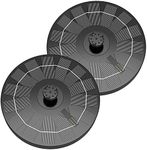Buying Guide for the Best Solar Pond Fountain
Choosing the right solar pond fountain can enhance the beauty of your garden or backyard while being environmentally friendly. Solar pond fountains use solar energy to power the pump, which means they are cost-effective and easy to maintain. When selecting a solar pond fountain, it's important to consider several key specifications to ensure you get the best fit for your needs. Understanding these specifications will help you make an informed decision and enjoy the benefits of a well-chosen fountain.Solar Panel PowerThe solar panel power is measured in watts and indicates how much energy the panel can generate from sunlight. This is important because it determines how efficiently the fountain will operate, especially on cloudy days. Solar panels typically range from 1.5W to 10W or more. For small ponds or birdbaths, a lower wattage (1.5W-3W) may suffice. For larger ponds or if you want a stronger water flow, opt for higher wattage (5W-10W). Consider your pond size and the amount of sunlight your location receives to choose the right power level.
Pump Flow RateThe pump flow rate, measured in gallons per hour (GPH) or liters per hour (LPH), indicates how much water the pump can move. This is crucial for determining the strength and height of the water spray. Flow rates can vary from 50 GPH to over 400 GPH. For small decorative fountains, a lower flow rate (50-150 GPH) is usually sufficient. For larger ponds or more dramatic water displays, a higher flow rate (200-400+ GPH) is recommended. Match the flow rate to your desired water effect and pond size.
Battery BackupA battery backup allows the fountain to operate even when there is no direct sunlight, storing energy for use during cloudy days or at night. This feature is important if you want continuous operation regardless of weather conditions. Battery capacities vary, with some providing a few hours of backup while others can last through the night. If you live in an area with inconsistent sunlight or want your fountain to run at night, choose a model with a reliable battery backup.
Spray Height and PatternsThe spray height and patterns refer to how high the water can be sprayed and the different shapes the water can form. This is important for aesthetic purposes and to ensure the fountain fits your visual preferences. Spray heights can range from a few inches to several feet. Some fountains come with interchangeable nozzles to create various patterns like a single jet, multiple streams, or a gentle bubble. Consider the visual impact you want to achieve and choose a fountain with the appropriate spray height and pattern options.
Durability and MaterialsThe durability and materials of the fountain determine how well it will withstand outdoor conditions. This is important for ensuring the longevity of your investment. Common materials include plastic, metal, and ceramic. Plastic is lightweight and affordable but may not be as durable. Metal is sturdy and long-lasting but can be prone to rust if not properly treated. Ceramic is aesthetically pleasing but can be fragile. Choose a material that balances durability with your aesthetic preferences and maintenance capabilities.
Ease of Installation and MaintenanceEase of installation and maintenance refers to how simple it is to set up and care for the fountain. This is important for ensuring you can enjoy your fountain without too much hassle. Some fountains are plug-and-play, requiring minimal assembly, while others may need more complex installation. Maintenance involves cleaning the pump and solar panel regularly to ensure optimal performance. If you prefer a low-maintenance option, look for a fountain with easy-to-clean components and straightforward installation instructions.










